 ...was the primary theme throughout RIAT 2001,
celebrating the achievements of the fairer sex in the realm of aviation. Although only the
one display pilot was female in Julie Wiles, 'Blue Eagle' Gazelle pilot (an opportunity
missed in
...was the primary theme throughout RIAT 2001,
celebrating the achievements of the fairer sex in the realm of aviation. Although only the
one display pilot was female in Julie Wiles, 'Blue Eagle' Gazelle pilot (an opportunity
missed in  inviting Carolyn Grace and her Spitfire T9), many of the static
participants sported female crews, principally the South African C-130
(including aircrew involved with Mozambique flood rescues at the end of 2000) and USANG
C-22. Women aircrew also represented the RAF, Army Air Corps, United States Air Force and
Navy, Royal Netherlands Air Force, Royal Danish Air Force, Turkish Air Force and the
Belgian Air Force and Army Air Corps. Nearly forty female aircrew from air forces around
the world were able to meet their trailblazing forerunners, members of the Air Transport
Auxiliary.
inviting Carolyn Grace and her Spitfire T9), many of the static
participants sported female crews, principally the South African C-130
(including aircrew involved with Mozambique flood rescues at the end of 2000) and USANG
C-22. Women aircrew also represented the RAF, Army Air Corps, United States Air Force and
Navy, Royal Netherlands Air Force, Royal Danish Air Force, Turkish Air Force and the
Belgian Air Force and Army Air Corps. Nearly forty female aircrew from air forces around
the world were able to meet their trailblazing forerunners, members of the Air Transport
Auxiliary.
- Women who like aviation #2
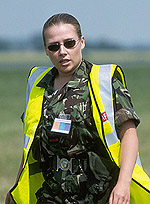
|
A pre-event symposium in Cambridge allowed 'Women in
Aviation' to exchange views and experiences ninety years after the UK's first female
aviator, Mrs Hilda Hewlett, was given a pilot's licence at
Brooklands Race Track. Hilda Beatrice Hewlett was born in the Victorian London of 1864, a
vicar’s daughter who went to art college and also trained as a nurse. Her husband
Maurice was a romantic novelist. Hilda’s life took a completely new direction when
she saw the first English flying meeting at Blackpool in 1909.
Adopting the alias "Grace Bird", Hilda arrived
at Mourmelon-le-Grand aerodrome in France later that year to study aeronautics. She met
Gustave Biondeau and they became business partners, united by a passionate belief in
aviation. 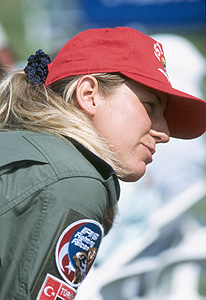 Returning to England with a Henri Farman bi-plane, the
"Blue Bird", Biondeau and Hewlett opened Britain's first flying school at
Brooklands race track in the summer of 1910.
Returning to England with a Henri Farman bi-plane, the
"Blue Bird", Biondeau and Hewlett opened Britain's first flying school at
Brooklands race track in the summer of 1910.
On 29 August 1911, aged 47, Hilda Hewlett was awarded
Ticket No. 122 and flew into the history books as Britain’s first woman pilot. She
promptly taught her son to fly, possibly the only naval airman in the world to be taught
to fly by his mother!
 When the Great War
broke out the Biondeau/Hewlett partnership went into the aircraft business, employing 700
people in their Bedfordshire plant to produce ten different types of planes. Later, aged
62, Hilda left England for New Zealand seeking escape from "crowds, convention and
civilisation". Her husband Maurice, from whom Hilda 'politely' separated in 1914, is
recorded as saying "Women will never be as successful in aviation as men. They have
not the right kind of nerve"!
When the Great War
broke out the Biondeau/Hewlett partnership went into the aircraft business, employing 700
people in their Bedfordshire plant to produce ten different types of planes. Later, aged
62, Hilda left England for New Zealand seeking escape from "crowds, convention and
civilisation". Her husband Maurice, from whom Hilda 'politely' separated in 1914, is
recorded as saying "Women will never be as successful in aviation as men. They have
not the right kind of nerve"!
Speaking just before RIAT 2001, the Chief of The Air
Staff, Air Chief Marshal Sir Peter Squire, said "I am delighted that RIAT salutes the
achievements of airwomen, from early pioneers to the young women who are increasingly at
the cutting edge of modern military airpower, both in the air and on the ground."
- ANNETTE HILL, AIR TRANSPORT AUXILIARY
- Annette Hill says that her love affair with aeroplanes began in 1935 when Sir Alan
Cobham arrived in her native Dublin with the famous Cobham Flying Circus. During a
five-shilling joy ride the pilot let Annette briefly take the controls, and she was
hooked.
-
- In 1942 Annette left her neutral country to join the WAAF in Northern Ireland as an
ambulance driver. The following year the 22 year-old applied for pilot training with the
ATA. She says "We fell into bed exhausted, but it was an exhilarating time. When I
graduated to the Spitfire it was a moment of pure magic mixed liberally with awe,
excitement and dread."
- Annette was posted to Prestwick as a Class II pilot to
ferry mostly Fleet Air Arm aircraft to the Isles and the north of Scotland. She became
known as "Queen of the Barracudas" - and a one-woman PR campaign for the
capabilities of this high-wing torpedo/dive bomber monoplane.
-
- From 1943 - 1945 Annette flew twelve different types of aircraft and clocked up 475
hours flying time.
|
Supplying the front-line
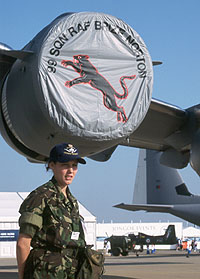 RIAT paid tribute to the women of the Air Transport Auxiliary who
delivered 309,011 aircraft during World War II, flying without instruments or weapons.
Renowned wartime ferry pilots Jackie Moggridge from Taunton and Joy Lofthouse from
Cirencester were among the ATA pilots who had the chance to swap yarns at Cottesmore with
today’s women flyers from United States, South Africa, Romania and Holland.
RIAT paid tribute to the women of the Air Transport Auxiliary who
delivered 309,011 aircraft during World War II, flying without instruments or weapons.
Renowned wartime ferry pilots Jackie Moggridge from Taunton and Joy Lofthouse from
Cirencester were among the ATA pilots who had the chance to swap yarns at Cottesmore with
today’s women flyers from United States, South Africa, Romania and Holland.
- Women who like aviation #3

|
The Air Transport Auxiliary (ATA) was formed in September
1939 to fly urgent mail in light aircraft but, with the outbreak of World War II just days
later, the role of the ATA became much more important. The new organisation began to
deliver factory aircraft to the RAF as it geared up for full-scale combat. For the first
few months, all ATA pilots were men.
In January 1940 the Government decided that experienced
women pilots could join the ATA. Miss Pauline Gower, a pilot with 2,000 flying hours,
recruited other women aviators to fly for the first time with the British military. The
original eight pilots eventually rose to 150, not only British but from the Commonwealth,
Europe and the USA. Three times as many men served with the ATA.
- Women who like aviation #4

|
At first women were only permitted to fly 'the light type
of aircraft'. As a shortage of pilots became more desperate common sense prevailed and
competent women flyers coped with everything from Tiger Moths to heavy four-engined
bombers. During World War II the ATA delivered 309,011 aircraft of 147 different types,
freeing over-stretched RAF pilots from routine duties.
Aircraft were handed over to the ATA as basic airframes,
with no instruments or weapons fitted. Before take-off the pilots were given a sheaf of
'handling notes' to be strapped to the knee for reference during the flight. There was
seldom time to practise in advance on unfamiliar aeroplanes.
Over 100 ATA pilots were lost in flying accidents.
Fifteen of these were women, including the legendary Amy Johnson who died on 5 January
1941. After running out of fuel in dense fog over the Thames Estuary, she bailed out of
the twin-engined Airspeed Oxford but died in the freezing waters. The ATA flag was hauled
down for the last time on 30 November 1945.
A modern-day Amy Johnson
- WOMEN OF THE 201st
 - Six women formed the crew of a US Air National Guard
Boeing 727 that arrived at Cottesmore. Between them, they have close to 100 years
experience serving with the world's biggest air force reserve.
-
- With more than 4,900 flying hours and 20 years in the
military, Colonel Linda K McTague is well placed to represent Women in Aviation. She
served with the US Air Force for eight years, including the USAF Academy at Colorado, and
currently commands the 201st Airlift Squadron. The unit is stationed at Andrews Air Force
Base in Maryland, also home to Air Force One, and carries out airlift and medical
evacuation missions world-wide.
-
- Other members of the crew are Lieutenant Colonel Dariene K
DeJesus, Senior Master Sergeant Le Juane Robinson, Senior Master Sergeant Gail Proctor,
Technical Sergeant Balkis Walker and Technical Sergeant Jennifer Perez. Senior Master
Sergeant Robinson is a member of the Air National Guard Diversity Working Group, set up to
resolve the problems of women aircrew making a flying career with the Air National Guard.
|
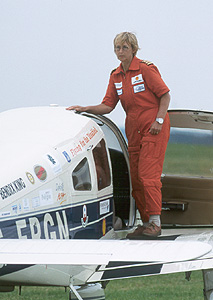 Another
guest of honour was Polly Vacher, 57, who arrived back in Britain on 16 May having
completed a record-breaking round-the-world flight in a tiny Piper
Dakota, not much bigger than a family estate car. Polly raised £160,000 for The Royal
International Air Tattoo Flying Scholarships for the Disabled, and she was joined at the
airshow by Sue Hanisch who learned to fly through the scheme after being badly injured in
an IRA bombing.
Another
guest of honour was Polly Vacher, 57, who arrived back in Britain on 16 May having
completed a record-breaking round-the-world flight in a tiny Piper
Dakota, not much bigger than a family estate car. Polly raised £160,000 for The Royal
International Air Tattoo Flying Scholarships for the Disabled, and she was joined at the
airshow by Sue Hanisch who learned to fly through the scheme after being badly injured in
an IRA bombing.
Polly touched down at Birmingham Airport on 17 May 2001
to complete an epic 29,000-mile flight. She is the first woman to fly single-handed around
the world via Australia in such a small aircraft; her record-breaking Piper Dakota is not
much bigger than a family estate car. The trip lasted 124 days, and in 47 hops she landed
in 17 countries. The former music teacher from Oxfordshire did not learn to fly until
1993, when she was living in Australia for two years.
- Women who like aviation #5
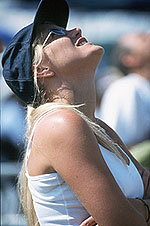
|
Polly took on the round-the-world challenge to raise
money for The Royal International Air Tattoo Flying Scholarships for the Disabled. Since
1983, when the scheme was established in memory of Group Captain Sir Douglas Bader, close
to 200 men and women with disabilities have experienced the joy of flying.
On Sunday Polly flew into the Flying Scholarships awards
ceremony aboard an RAF Harrier T10 flown by Squadron Leader Al Pinner of IV(F) Squadron,
which is based at RAF Cottesmore. A single Harrier had taken to the air to wish Polly
‘bon voyage’ when she left Birmingham in May, and 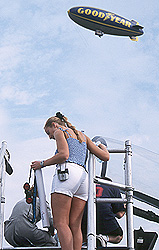 two of them escorted her
when she arrived back, dipping their noses in salute at her achievement.
two of them escorted her
when she arrived back, dipping their noses in salute at her achievement.
At the awards ceremony Polly presented a cheque for
£160,000 to HRH Prince Feisal of Jordan. When invested this money will provide an annual
scholarship in perpetuity so in the years to come there will be many disabled men and
women with every reason to be grateful to Polly and her remarkable achievement.
 Training
the RIAT way
Training
the RIAT way
 Training was the
other main theme for RIAT 2001, and it brought together an interesting array of training
airframes from around the world. Perhaps rarest was the Bulldog
from the Armed Forces of Malta, an epic journey for such a small aeroplane and doubly
appropriate as the RAF retired its last example a couple of months ago. Two Hungarian L-39s added an ‘iron curtain’ flavour, enhanced by the MAKO
mock-up. A gorgeous all-black Saab Sk60 (aka 105) from Sweden
showed just how to do national
Training was the
other main theme for RIAT 2001, and it brought together an interesting array of training
airframes from around the world. Perhaps rarest was the Bulldog
from the Armed Forces of Malta, an epic journey for such a small aeroplane and doubly
appropriate as the RAF retired its last example a couple of months ago. Two Hungarian L-39s added an ‘iron curtain’ flavour, enhanced by the MAKO
mock-up. A gorgeous all-black Saab Sk60 (aka 105) from Sweden
showed just how to do national 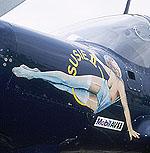 markings on
a black paint scheme, evoking memories of those JPS-backed Lotuses of Mario Andretti some
twenty-three years ago.
markings on
a black paint scheme, evoking memories of those JPS-backed Lotuses of Mario Andretti some
twenty-three years ago.
The training theme provided two segments to the flying display, the first dedicated to
RAF training, starting with the Firefly and Tucano, ending with
the mighty Tornado F3. The only element missing was the Grob Tutor,
but as it doesn’t actually form part of the pilot’s training plan (being used
for CFS, UAS and AEF duties) it didn’t detract from the career path offered.
The second segment of the display was much shorter, being ‘Other Nations’
Training’ and represented by the Belgian Alpha Jet and
Dutch PC-7. The latter was deputising for the Slovenian PC-9 which
hadn’t made it to Cottesmore, but was a more colourful and definitely smoky display
than the ‘9 would have been.
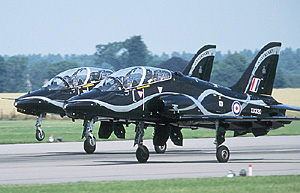 Celebrating
its 60th birthday was the Air Training Corps, noticeable by the number of
cadets roaming the airfield, and which had a visit from HRH Princess Alexandra who is
Honorary Air Commodore of RAF Cottesmore. Cottesmore’s Station Commander, Group
Captain David Walker, was himself a cadet in his formative years and he paid tribute to
the organisation in his opening speech, confirming there nearly as many cadets in the ATC
as there are full-timers in the RAF! During the ‘Lazy lunch’ section gliders
from the RAFG&SA demonstrated what potential ATC recruits can look forward to during
many weekends throughout the year.
Celebrating
its 60th birthday was the Air Training Corps, noticeable by the number of
cadets roaming the airfield, and which had a visit from HRH Princess Alexandra who is
Honorary Air Commodore of RAF Cottesmore. Cottesmore’s Station Commander, Group
Captain David Walker, was himself a cadet in his formative years and he paid tribute to
the organisation in his opening speech, confirming there nearly as many cadets in the ATC
as there are full-timers in the RAF! During the ‘Lazy lunch’ section gliders
from the RAFG&SA demonstrated what potential ATC recruits can look forward to during
many weekends throughout the year.
Part three:
Tributes, Tornados and T'other things



 ...was the primary theme throughout RIAT 2001,
celebrating the achievements of the fairer sex in the realm of aviation. Although only the
one display pilot was female in Julie Wiles, 'Blue Eagle' Gazelle pilot (an opportunity
missed in
...was the primary theme throughout RIAT 2001,
celebrating the achievements of the fairer sex in the realm of aviation. Although only the
one display pilot was female in Julie Wiles, 'Blue Eagle' Gazelle pilot (an opportunity
missed in 

 Returning to England with a Henri Farman bi-plane, the
"Blue Bird", Biondeau and Hewlett opened Britain's first flying school at
Brooklands race track in the summer of 1910.
Returning to England with a Henri Farman bi-plane, the
"Blue Bird", Biondeau and Hewlett opened Britain's first flying school at
Brooklands race track in the summer of 1910. When the Great War
broke out the Biondeau/Hewlett partnership went into the aircraft business, employing 700
people in their Bedfordshire plant to produce ten different types of planes. Later, aged
62, Hilda left England for New Zealand seeking escape from "crowds, convention and
civilisation". Her husband Maurice, from whom Hilda 'politely' separated in 1914, is
recorded as saying "Women will never be as successful in aviation as men. They have
not the right kind of nerve"!
When the Great War
broke out the Biondeau/Hewlett partnership went into the aircraft business, employing 700
people in their Bedfordshire plant to produce ten different types of planes. Later, aged
62, Hilda left England for New Zealand seeking escape from "crowds, convention and
civilisation". Her husband Maurice, from whom Hilda 'politely' separated in 1914, is
recorded as saying "Women will never be as successful in aviation as men. They have
not the right kind of nerve"!
 RIAT paid tribute to the women of the Air Transport Auxiliary who
delivered 309,011 aircraft during World War II, flying without instruments or weapons.
Renowned wartime ferry pilots Jackie Moggridge from Taunton and Joy Lofthouse from
Cirencester were among the ATA pilots who had the chance to swap yarns at Cottesmore with
today’s women flyers from United States, South Africa, Romania and Holland.
RIAT paid tribute to the women of the Air Transport Auxiliary who
delivered 309,011 aircraft during World War II, flying without instruments or weapons.
Renowned wartime ferry pilots Jackie Moggridge from Taunton and Joy Lofthouse from
Cirencester were among the ATA pilots who had the chance to swap yarns at Cottesmore with
today’s women flyers from United States, South Africa, Romania and Holland. 


 Another
guest of honour was Polly Vacher, 57, who arrived back in Britain on 16 May having
completed a record-breaking round-the-world flight in a tiny
Another
guest of honour was Polly Vacher, 57, who arrived back in Britain on 16 May having
completed a record-breaking round-the-world flight in a tiny 
 two of them escorted her
when she arrived back, dipping their noses in salute at her achievement.
two of them escorted her
when she arrived back, dipping their noses in salute at her achievement. Training
the RIAT way
Training
the RIAT way
 markings on
a black paint scheme, evoking memories of those JPS-backed Lotuses of Mario Andretti some
twenty-three years ago.
markings on
a black paint scheme, evoking memories of those JPS-backed Lotuses of Mario Andretti some
twenty-three years ago.


 Celebrating
its 60th birthday was the Air Training Corps, noticeable by the number of
cadets roaming the airfield, and which had a visit from HRH Princess Alexandra who is
Honorary Air Commodore of RAF Cottesmore. Cottesmore’s Station Commander, Group
Captain David Walker, was himself a cadet in his formative years and he paid tribute to
the organisation in his opening speech, confirming there nearly as many cadets in the ATC
as there are full-timers in the RAF! During the ‘Lazy lunch’ section gliders
from the RAFG&SA demonstrated what potential ATC recruits can look forward to during
many weekends throughout the year.
Celebrating
its 60th birthday was the Air Training Corps, noticeable by the number of
cadets roaming the airfield, and which had a visit from HRH Princess Alexandra who is
Honorary Air Commodore of RAF Cottesmore. Cottesmore’s Station Commander, Group
Captain David Walker, was himself a cadet in his formative years and he paid tribute to
the organisation in his opening speech, confirming there nearly as many cadets in the ATC
as there are full-timers in the RAF! During the ‘Lazy lunch’ section gliders
from the RAFG&SA demonstrated what potential ATC recruits can look forward to during
many weekends throughout the year.